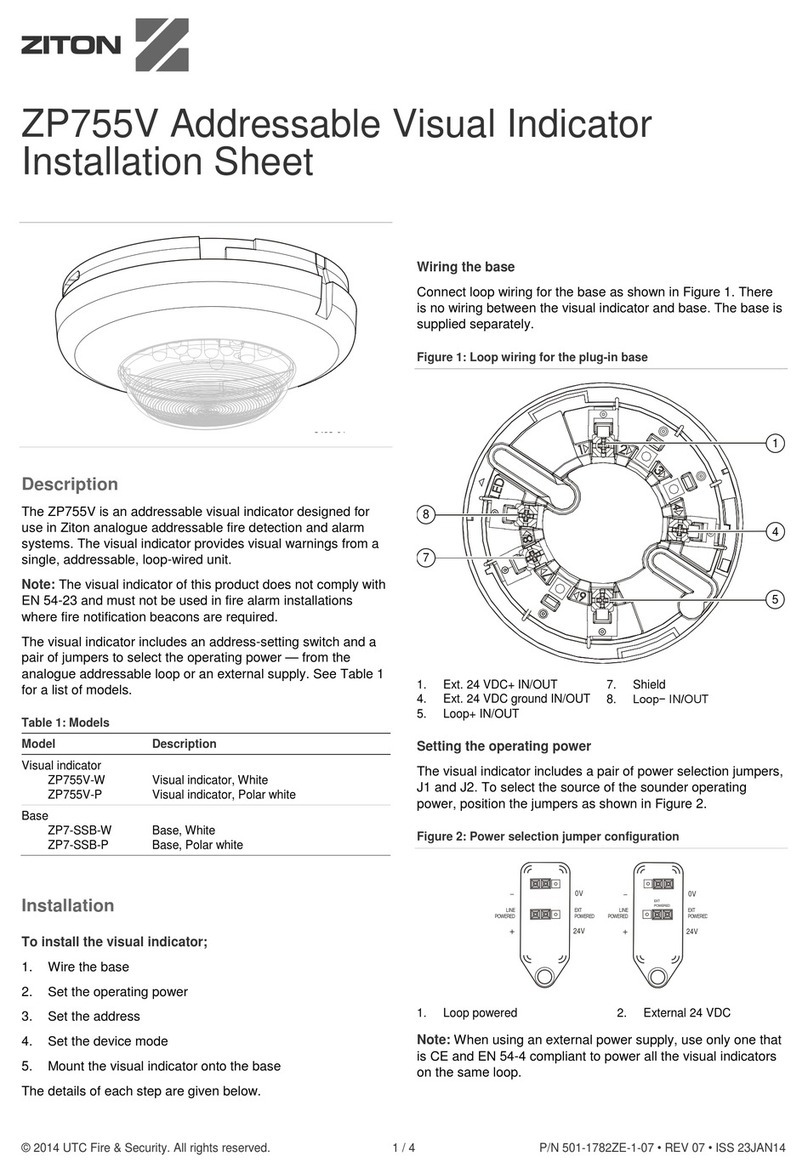
P/N 03-0210-501-2400-02 • ISS 04NOV22 9 / 22
Advertencias y declaraciones sobre el
producto
ESTOS PRODUCTOS ESTÁN DESTINADOS A LA VENTA E
INSTALACIÓN POR UN PROFESIONAL DE SEGURIDAD
EXPERIMENTADO. CARRIER FIRE & SECURITY B.V. NO
PUEDE GARANTIZAR QUE TODA PERSONA O ENTIDAD
QUE COMPRE SUS PRODUCTOS, INCLUYENDO
CUALQUIER «DISTRIBUIDOR O VENDEDOR
AUTORIZADO», CUENTE CON LA FORMACIÓN O
EXPERIENCIA PERTINENTE PARA INSTALAR
CORRECTAMENTE PRODUCTOS RELACIONADOS CON
LA SEGURIDAD.
Para obtener más información sobre
exclusiones de garantía e información de
seguridad de productos, consulte
https://firesecurityproducts.com/policy/product
-
warning/ o escanee el código QR:
FR : Instructions d’installation
Description
Le déclencheur manuel d’alarme adressable intelligent de la
gamme ZP880, résistant aux intempéries, est conçu pour une
utilisation en extérieur et prend en charge le protocole Ziton
ZP7.
Toutes les unités sont dotées d’un élément réinitialisable.
Celui-ci peut être remplacé par un élément sécable, si
nécessaire (numéro de commande : N-MC-FE). Reportez-vous
à la section Remise en place de l’élément réinitialisable, à la
page 10.
Figures
1 : Trous de fixation et dimensions
Figure 2 : Bornier avant et DIP Switch
3 : Déverrouillage du couvercle avant
4 : Retrait du couvercle avant
5 : Retrait de l’élément réinitialisable
Figure 6 : Remise en place du couvercle avant
Installation
Attention : ce produit doit être installé et entretenu par une
personne qualifiée, conformément à toutes les normes
nationales et régionales, et à toutes les autres réglementations
applicables.
Adressage
Avant de procéder à l’installation, configurez l’adresse du
dispositif à l’aide du DIP Switch, situé à l’arrière du boîtier
avant (reportez-vous à la Figure 2).
001-127 correspond à la plage d’adresses. Reportez-vous au
tableau se trouvant sur la dernière page de ce document afin
d’obtenir des informations sur le positionnement du DIP Switch
pour chaque adresse.
Remarque : si vous modifiez l’adresse du dispositif après
l’installation, vous devez déconnecter le dispositif de
l’alimentation en boucle pendant au moins une seconde, puis
le reconnecter afin que la nouvelle adresse soit reconnue.
Installation
Le déclencheur manuel d’alarme est monté en surface.
Assurez-vous de retirer le cache anti-poussière après la mise
en service.
Remarque : le cache anti-poussière peut également être
utilisé pour indiquer que l’unité n’est pas opérationnelle (par
exemple, avant la mise en service, en cas de maintenance ou
de désactivation, etc.)
Pour monter le déclencheur manuel d’alarme en surface :
1. Vissez le manchon et les bouchons d’étanchéité fournis
dans les trois sorties de câble du boîtier arrière.
Assurez-vous que le joint en caoutchouc est présent.
2. Fixez le boîtier arrière au mur à l’aide de quatre vis M4
(non fournies) et faites passer le câble à travers le
manchon.
En fonction du type d’installation, le boîtier arrière peut
comporter deux sorties de câble sur le haut et une sur le
bas, ou une sur le haut et deux sur le bas.
Reportez-vous à la Figure 1 pour consulter l’emplacement
des trous de fixation.
3. Connectez le câble au bornier fourni, puis branchez ce
dernier au connecteur CCI à l’arrière du boîtier avant
(reportez-vous à la Figure 2).
À l’aide du câble de liaison fourni, testez la continuité du
câble avant de brancher le bornier au connecteur CCI à
l’arrière du boîtier avant.
Reportez-vous à la section Câblage ci-dessous, dédiée
aux connexions du bornier et aux caractéristiques du
câble.
4. Déverrouillez et retirez le couvercle avant.
Pour déverrouiller le couvercle avant, insérez la clé et
tournez-la dans le sens des aiguilles d’une montre. Dès
que vous entendez deux clics, tirez le couvercle vers le
bas pour le retirer (reportez-vous aux Figures 3 et 4).
5. Fixez la face avant au boîtier à l’aide des quatre vis
fournies.
Reportez-vous à la Figure 5 pour consulter l’emplacement
des trous de fixation.
6. Remettez le couvercle avant en place (voir la Figure 6).
Tournez la clé dans le sens inverse des aiguilles d’une
montre (jusqu’à ce que vous entendiez deux clics) pour
verrouiller le couvercle, puis retirez la clé.
Enfin, testez le déclencheur manuel d’alarme (reportez-vous à
la section Tests, à la page 10).






























